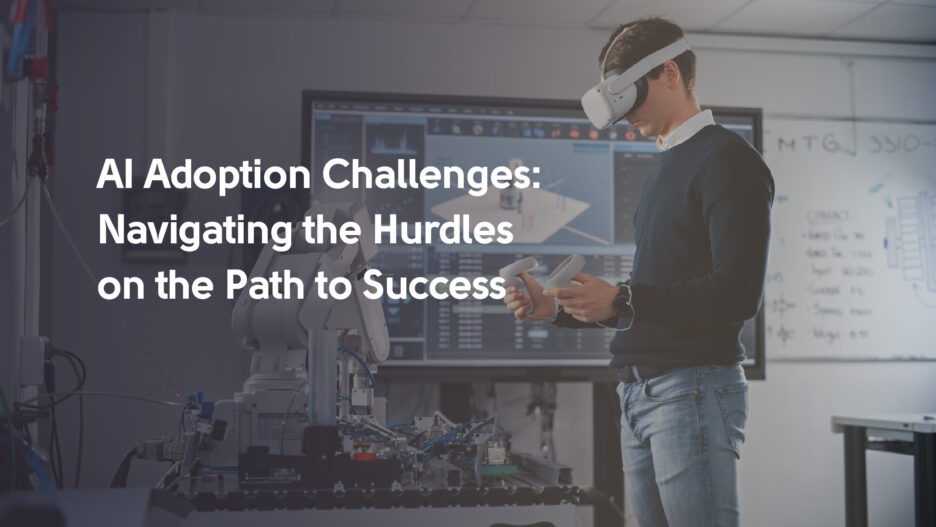You’d be living under a rock to fail to realize that Artificial Intelligence (AI), and associated tech like Generative AI, machine learning, large language models (LLMs), and more, have become the buzzwords of the decade, with businesses across industries eagerly exploring their transformative potential. And the hype is warranted, to say the least.
From automating routine tasks to deriving valuable insights from massive amounts of data, AI is promising and delivering a revolutionized approach to how we work and live, driving efficiency and innovation to new territories. However, amidst the hype and excitement, it's crucial to recognize that AI is not a magic wand that can instantly solve all business problems and challenges.
In fact, serious, equally troublesome and dangerous concerns are being raised. For instance, early research is beginning to show that the equivalent of a bottle of water is wasted for every 20-50 prompts asked to Generative AI tools. While the environmental concerns of AI are yet to be fully uncovered, more research is available, paired with global uproar about privacy violations, market volatility, uncontrollable self-aware AI, deepfakes, job loss, socioeconomic inequality, and more.
And those fears and concerns are nothing to throw to the wind. For instance, by 2030, McKinsey research finds that tasks taking up to 30% of worked hours in the U.S. could be automated. Black and Hispanic employees are especially vulnerable to this shift. Goldman Sachs research states that 300 million full-time jobs could be at risk thanks to AI automation.
The economic, social, and cultural concerns around AI do not outweigh technology's many benefits. When listing the many positive effects AI has across enterprises and industries, greater cost efficiencies, positive return on investment (ROI), higher performance, and increased quality are just the tip of the iceberg. Gartner found that executives have increased AI investments by up to 45%, and 70% of those executives confirmed their organizations are exploring the potential of Generative AI. Case in point, it’s forecasted that the global market for Generative AI will increase 36.1% by 2032.
However, before embarking on an AI adoption journey, organizations must carefully consider the potential hurdles and thoroughly understand the ROI of implementing AI solutions. While AI can undoubtedly bring significant benefits, it requires careful planning, strategic alignment, and a clear understanding of how it will ultimately aid in achieving business objectives.
In this article, we'll delve into the common challenges organizations face when adopting AI technologies. By shedding light on these hurdles and providing practical strategies to overcome them, we aim to equip you with the knowledge and tools necessary to navigate the AI landscape successfully. Whether you are a business leader, an IT professional, or a stakeholder involved in AI initiatives, understanding these challenges will help you prepare in advance and set the stage for a successful AI implementation.
So, let's explore the key AI adoption challenges and uncover how to tackle them head-on, paving the way for a transformative and rewarding AI journey.
Common Challenges in AI Adoption
AI adoption is plagued with obstacles, some of which arise when organizations fail to prepare carefully thought-out strategies to ensure a successful implementation. Let's examine some of the most common hurdles encountered during AI adoption.
Data Quality and Availability
Imagine building a house on a shaky foundation. No matter how impressive the architecture or how skilled the builders are, the house will always be vulnerable to collapse. The same principle applies to AI adoption. Data is the bedrock upon which AI systems are built, and without high-quality, reliable data, even the most advanced AI algorithms will fail to deliver accurate results.
Poor data quality, inconsistencies, and incompleteness can severely impact the accuracy and effectiveness of AI models. Moreover, collecting, cleaning, and preparing data for AI consumption can be time-consuming and resource-intensive. Ensuring data availability and accessibility across different systems and silos adds another layer of complexity to the data management process.
To top it off, AI and deep learning models can be complex and challenging to understand and apply, even for those who work closely with these technologies. This complexity often results in a lack of transparency regarding how and why AI reaches certain conclusions, leaving gaps in understanding about the data AI algorithms use and the reasons behind potentially biased or unsafe decisions. These issues have driven the adoption of explainable AI, yet the widespread implementation of transparent AI systems remains a work in progress.
Poor data quality and availability can have substantial consequences for AI initiatives. Inaccurate or biased data can lead to flawed AI models, resulting in misleading insights, incorrect predictions, and, ultimately, poor business decisions.
Complexity of AI Algorithms
AI constantly evolves, with new algorithms and techniques emerging at break-neck speed. From deep learning neural networks to reinforcement learning, AI techniques' sheer variety and sophistication can be overwhelming.
Understanding and implementing these complex algorithms can be daunting, especially for organizations with limited AI expertise. Selecting the right algorithms, tuning hyperparameters, and optimizing models requires deep technical knowledge and experience.
The challenge lies not only in understanding the theoretical underpinnings of these algorithms but also in effectively applying them to real-world business problems. Organizations must navigate the trade-offs between accuracy, interpretability, and computational efficiency while ensuring the algorithms align with their specific use cases and goals.
Underestimating the complexity of AI algorithms can have severe consequences. Poorly designed or implemented algorithms can lead to inaccurate predictions, biased outcomes, longer development cycles, increased costs, project failures, and wasted resources.
Integration with Existing IT Infrastructure
Imagine trying to fit a square peg into a round hole. That's the challenge many organizations face when integrating AI solutions into their IT infrastructure. The puzzle of compatibility can be a daunting one, with legacy systems, disparate technologies, and data silos all vying for attention.
Integrating AI solutions into an organization's IT infrastructure is another significant challenge. Ensuring smooth integration and interoperability between AI components and the IT ecosystem requires careful planning, architectural design, and extensive testing. The complexity of integration can strain IT resources and lead to delays in AI deployment.
Poor AI integration can have substantial consequences. Inefficiencies, data inconsistencies, and performance bottlenecks can plague the entire AI pipeline, undermining the technology's potential benefits.
Ethical and Regulatory Concerns
Imagine entrusting your data to an AI system, not knowing how it will be used or who can access it. The issue of data privacy looms large in the era of AI, with the potential for misuse and unauthorized access, causing alarm bells to ring.
As AI becomes more prevalent, ethical and regulatory concerns are in the spotlight. Data privacy, algorithmic bias, transparency, and accountability must be addressed to ensure responsible AI adoption. Organizations must navigate a complex landscape of regulations, such as the General Data Protection Regulation (GDPR) and industry-specific guidelines — take the healthcare industry where entities must adhere to HIPAA and FERPA — to ensure compliance and maintain public trust. Failing to address ethical and regulatory considerations can result in legal repercussions, reputational damage, and loss of customer confidence.
Moreover, the specter of algorithmic bias haunts the AI landscape. AI models, trained on historical data, can inadvertently perpetuate and amplify societal biases, leading to discriminatory outcomes.
The lack of transparency in AI decision-making processes further compounds ethical concerns. The "black box" nature of many AI algorithms makes it difficult to understand how decisions are made and hold systems accountable.
Organizational Resistance
Implementing AI often requires significant changes to existing processes, roles, and organizational structures. This can trigger resistance from employees who may fear job displacement or feel uncertain about the impact of AI on their work. Resistance to change shows many facets including skepticism, lack of buy-in, and reluctance. Overcoming organizational resistance requires effective change management strategies, clear communication, employee training, and upskilling programs.
In the next section, we will explore practical strategies and best practices for overcoming these challenges and unlocking AI's full potential in your organization.
Overcoming AI Adoption Challenges: A Roadmap to Success
With a strong insight into many organizations' AI adoption obstacles, we can now think about what makes an AI implementation successful and what makes it stick.
By observing strategic initiatives and best practices across various sectors, we can find common ground and the essential nuances for success in an AI-driven world. And most importantly, by implementing these strategic initiatives and best practices in our AI projects, we can find ourselves better equipped to solve today's and tomorrow's problems.
Let's explore the key steps to overcome AI adoption challenges and pave the way for a successful AI journey.
Establish Data Governance Practices and Guidelines
Artificial intelligence requires a sufficient data supply and governance mechanisms to address the associated problems. One might think that AI relies on the much-touted surge in big data. However, recent advances have shown that even if you reduce the depth of a trained neural network, you can still beat an unfathomably large model at many tasks. Deep learning now enters realms from which it had previously been excluded because big data is scarce in those realms.
Organizations can use a sturdy data governance foundation to supply AI with the refined, trustworthy data it needs. When is data governance not a good thing? Always, of course. But especially when AI is hoping to pull through. Building and maintaining a data regime that governs the selection and validation of data—making sure numbers are accurate, for example — is manna for AI. But it also pays its dues regarding risk management and building trust.
To implement effective data governance, organizations should:
- Clearly delineate who owns each dataset and assign stewardship roles
- Establish data quality standards and validation processes
- Implement data security measures and access controls
- Create methods to follow the data through from its origin to all the places it ends up
- Perform frequent data governance practice audits and stay watchful of how well these are carried out
Staff Upskilling and Reskilling to Build Expertise
Developing the talents of our workforce by providing opportunities for their continual learning is a priority at our company. We do this because we know that to provide the highest quality of products and services that our clients deserve, we need staff who have the most current and the highest level of expertise.
The AI workforce is expected to operate with greater labor intensity than the current traditional computing workforce, both because service demands will increase (providing more income to AI workers) and because the services will take more AI worker time. Consequently, there is the prospect that AI technologies will replace traditional technologies in many service sectors. Although some service sectors have long had major labor content (think hotel maids, fast food workers, and janitors), even in services performed before much of an audience, AI systems may increasingly do the work.
Initiatives that focus on upskilling and reskilling should encompass a wide range of subject matters. They should start from basic AI concepts and move toward advanced programming techniques. They are like equipping a team of explorers with the knowledge and tools they need to navigate a new landscape. Similarly, by building internal AI skills, businesses can reduce their dependence on external consultants and instead create a fertile ground for their innovation.
To implement effective upskilling and reskilling programs, organizations should:
- Conduct a skills gap analysis to identify training needs
- Develop a comprehensive AI training curriculum
- Leverage online courses, workshops, and hands-on projects
- Encourage cross-functional collaboration and knowledge sharing
- Provide mentorship and guidance from experienced AI practitioners
- Recognize and reward employees for their AI skill development
Thorough AI Implementation Plan to Ensure Seamless Integration
Integrating AI solutions into existing IT infrastructure can be a complex and daunting task. To overcome this challenge, organizations must develop a thorough AI implementation plan that considers the intricacies of their IT ecosystem. This involves conducting a comprehensive assessment of existing systems, identifying integration points, and designing a robust architecture that can accommodate AI components.
A well-crafted AI implementation plan should also include testing, validation, and performance monitoring provisions. It's like creating a detailed blueprint for a construction project – every aspect must be carefully considered and mapped out to ensure a seamless execution. By taking a systematic approach to AI integration, organizations can minimize disruptions and maximize the value of their AI investments.
To develop a thorough AI implementation plan, organizations should:
- Conduct a thorough assessment of existing IT infrastructure
- Identify integration points and dependencies
- Design a scalable and modular architecture for AI integration
- Define clear roles and responsibilities for implementation teams
- Establish testing and validation procedures
- Develop performance metrics and monitoring mechanisms
- Create a rollout and deployment strategy
- Plan for ongoing maintenance and updates
Culture Shift that Fosters Adoption of AI Initiatives
Organizational resistance can be a significant barrier to AI adoption. To overcome this challenge, organizations must foster a culture shift that embraces AI and encourages employees to participate in AI initiatives actively. This involves creating an environment that values innovation, continuous learning, and experimentation.
Leadership plays a crucial role in driving this culture shift. By communicating the benefits of AI, addressing concerns, and leading by example, leaders can inspire and motivate employees to embrace AI technologies. It's like planting and nurturing the seeds of change with care and attention.
To foster a culture shift that supports AI adoption, organizations should:
- Communicate the vision and benefits of AI clearly and consistently
- Encourage open dialogue and address concerns transparently
- Provide training and workshops to build AI literacy across the organization
- Celebrate successes and share AI adoption stories
- Encourage experimentation and risk-taking
- Recognize and reward employees who contribute to AI initiatives
- Cultivate a mindset of continuous learning and improvement
Ethical AI Framework for Responsible Adoption
As organizations navigate the ethical and regulatory landscape of AI, it's crucial to establish an ethical AI framework. This framework should guide the responsible development, deployment, and use of AI technologies, ensuring fairness, transparency, and accountability.
An ethical AI framework should include data privacy and security guidelines, algorithmic fairness and bias mitigation, and explainable AI. It's like creating a moral compass for the organization – a set of principles that guide decision-making and ensure the ethical use of AI.
To establish an ethical AI framework, organizations should:
- Develop clear guidelines for data privacy and security
- Implement measures to detect and mitigate algorithmic bias
- Ensure transparency in AI decision-making processes
- Establish accountability mechanisms for AI systems
- Engage with stakeholders to understand and address ethical concerns
- Continuously monitor and update the ethical AI framework
Embracing AI with Confidence
AI adoption is not a one-time thing. Instead, it is an unfolding series of steps that organizations take as they move ahead with artificial intelligence. Ideally, these steps occur in the context of strong data governance, with the conditions in place to boost confidence in the AI system.
We won’t sugarcoat it: achieving successful AI adoption demands hard work, commitment, and continuous learning. Only then will organizations unlock AI's fabled, high-value potential and apply it effectively in their day-to-day operations. And be warned: the path to perfecting AI is long—and sometimes a bit perilous.
But the secret sauce isn't really a secret. It's mashing up machine learning (ML), which forms the core of most AI systems, with the kind of subject matter expertise that most successful AI projects can't do without and few companies possess.
Our advice? Embrace AI with curiosity, adaptability, and determination. Face the challenges that will surely come your way head-on, all to drive innovation and growth forward.
To learn more about how Svitla Systems can support your organization in overcoming AI adoption challenges and achieving AI success, explore our consulting services offering.





